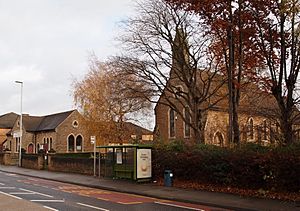Church of St John the Evangelist, Hucknall facts for kids
Quick facts for kids Church of St John the Evangelist, Hucknall |
|
|---|---|

St John the Evangelist's Church, Hucknall
|
|
| Denomination | Church of England |
| Churchmanship | Broad Church |
| Website | www.stjohnshucknall.org.uk |
| History | |
| Dedication | St John the Evangelist |
| Administration | |
| Parish | Hucknall |
| Diocese | Southwell and Nottingham |
| Province | York |
The Church of St John the Evangelist, Hucknall is a special church that serves the local community. It is part of the Church of England and is located in the Butler's Hill area of Hucknall, a town in Nottinghamshire, England. A "parish church" is a church that looks after the spiritual needs of people living in a specific local area, called a parish.
Contents
Building the Church: A Look Back in Time
The Church of St John the Evangelist was built between 1876 and 1877. The land for the church, which was about one acre, was generously given by the fifth Duke of Portland.
Who Designed the Church?
Two architects, Frederick Bakewell and Albert Nelson Bromley, designed the church. They used local Linby stone for most of the building. They also added Bath stone for decorative parts and brick for strong supports called buttresses.
When Was the Church Finished?
The first stone, known as the foundation stone, was laid in 1876. The church cost about £1,300 to build, which was a very large sum of money back then! Bishop Tozer officially opened and blessed the church on March 6, 1877. He was an assistant bishop from the Diocese of Lincoln. The church was built to help the many miners and their families who lived in the Butler's Hill area of Hucknall.
Changes and Additions Over the Years
- Chancel: In 1895, a part of the church called the chancel was added. This section is usually where the altar is located. It was designed by architect Robert Charles Clarke.
- Sanctuary: The sanctuary, which is the area around the altar, was completely updated in 1925. New items were added, including the altar itself, a decorative screen behind it called a reredos, and special chairs. A highly carved bishop's chair was also introduced.
- Nave Chairs: The chairs in the main part of the church, called the nave, have rush bottoms and have been there since 1877.
Unique Features of the Church
- Rood Crucifix: The church has a very special rood crucifix. This is a cross with a figure of Jesus on it, hanging in the archway that separates the chancel from the nave. The wooden cross itself was originally from the grave of a local person who died in the First World War.
- Windows: Most of the church windows are single, tall, narrow windows called lancets. Above two windows at the west end of the church, there is a round window with a four-leaf design called a quatrefoil. These specific windows remember local miners who died in World War II.
- East Window: The most artistic window is the large east window. It shows the Crucifixion, which is the scene of Jesus on the cross. This beautiful window is a memorial to the men from Butler's Hill who died in the Great War (World War I).
Who Leads the Church?
The people who lead the church are called incumbents. They are like the main ministers or priests.
Past and Present Leaders
- Revd Penny Compton
- Revd David Ford has been the vicar since 2011.
How the Church Works Today
The Church of St John the Evangelist is part of a group of churches that work together. This group includes:
- The Church of St John the Evangelist itself
- Church of St Mary Magdalene, Hucknall
- Church of St Peter and St Paul, Westville

